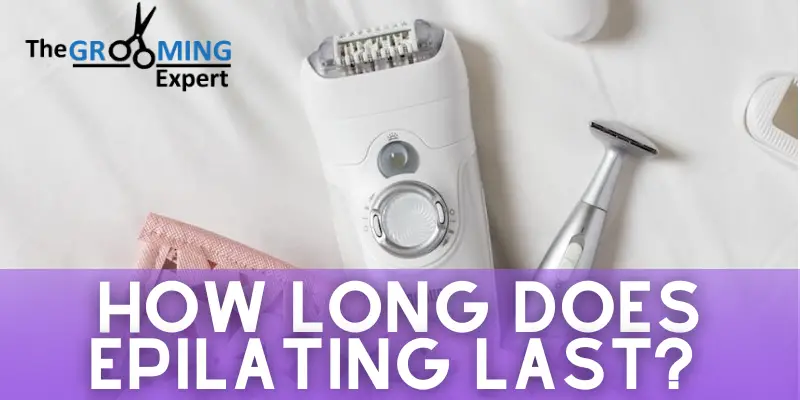Epilating is a hair removal method involving an electric device that grasps multiple hairs simultaneously and pulls them out from the root. It’s a popular alternative to waxing or shaving, providing longer-lasting results. But How Long Does Epilating Last Exactly?
In this article, we’ll explore the factors that affect the longevity of epilation and how to make your results last as long as possible. Moreover, you will learn about the tips to last the epilation results later in the article.
Factors that Affect the Longevity of Epilation
These are the factors that affect the Epilation age.
1. Hair growth cycle
Your hair’s growth cycle is crucial to how long your epilation results last. Hair goes through three phases of growth: anagen, catagen, and telogen. The anagen phase is the active growth phase, and the hair is still attached to the root during this phase.
In contrast, during the catagen and telogen phases, the hair detaches from the root and falls out. When you epilate, you pull the hair out from the root so the results can last for weeks. However, the hair growth cycle varies between individuals and body parts. Some people have a shorter growth cycle, meaning the hair will grow back faster.
2. Hair thickness and density
The thickness and density of your hair also affect how long your epilation results last. Thicker hair is more challenging to remove, and it can take longer for the hair to grow back. However, if your hair is too thin, the epilator may not be able to grasp it correctly, which can lead to incomplete hair removal.
3. Skin type
Your skin type can also affect how long your epilation results last. People with dry skin tend to have longer-lasting results because the hair follicles are more exposed, making it easier for the epilator to grasp the hair. On the other hand, people with oily skin may have a harder time with epilation because the hair follicles are hidden under the skin’s surface.
4. Personal hair growth rate
Individual hair growth rates can also affect how long the results of epilating last. Some people may have a faster hair growth rate than others, which means their hair will grow back sooner. On the other hand, some people may have a slower hair growth rate, which means the results of epilating may last longer for them.
You can read about Does Epilation Reduce Hair Growth?
5. Frequency of epilating
The frequency of epilating can also affect how long the results last. The more often you epilate, the weaker the hair follicles become, and the slower the hair grows back. Over time, this can lead to longer-lasting results as the hair follicles become weaker and produce hair more slowly.
6. Proper technique
Finally, the proper technique is essential for achieving long-lasting results with epilating. Using the device incorrectly or at the wrong angle can lead to uneven hair removal or breakage, which can cause the hair to grow back sooner. It’s important to follow the instructions carefully and take your time to ensure that the device is used correctly.
Why don’t you read about How to Use Epilator on Face
How long does epilating last?
Epilating lasts for about 2-4 weeks. However, this varies from person to person as some people may experience regrowth sooner than others. The length of epilation also depends on how often you epilate and how coarse your hair is. If you epilate regularly (about once a week), you will likely see longer-lasting results.
On Armpits
Epilation of armpits last depends on a few factors. These include the device used, the individual’s hair growth cycle, and the person’s pain tolerance. Generally, though, epilating armpits lasts for about two to four weeks.
For some people, epilating armpits may last even longer. Their hair growth cycles are slower than average, or they have a higher pain tolerance threshold. If you fall into either of these categories, you can expect your results to last up to six weeks.
On Face
When epilating the face, expect the hair to grow back within 2 to 4 weeks. However, this varies from person to person. If you have thick facial hair, it may take longer for the hair to grow back. Epilation removes the hair from the root, so it will take some time for new hair to grow in its place.
Tips to Prolong the Results of Epilating
Epilating is a hair removal method that removes hair from the root, resulting in smooth skin. Here are some tips to help prolong the results of epilating:
- Exfoliate regularly: Exfoliating your skin helps to remove dead skin cells, which can clog hair follicles and prevent hair from growing out properly. Use a gentle scrub or a body brush to exfoliate your skin before and after.
- Moisturize: Keeping your skin moisturized is essential for maintaining smooth skin after epilating. Apply a moisturizer or body lotion after to hydrate and soothe your skin.
- Avoid tight clothing: Tight clothing can rub against the skin and irritate it, leading to ingrown hairs. Wear loose clothing after epilating to allow your skin to breathe.
- Don’t shave between sessions: Shaving can disrupt the hair growth cycle and make it harder for hairs to grow back properly. Try to avoid shaving between epilating sessions to maintain the benefits of epilating.
- Be consistent: Regularly Epilating can help weaken hair follicles, making hair grow slower and thinner. Stick to a consistent epilating routine to achieve the best results.
- Keep your epilator clean: Keeping your epilator clean and free from bacteria can help to prevent infections and skin irritation. Clean your epilator after each use and replace the epilating head regularly.
You can also read: Trimmer vs Epilator: Difference between Trimmer and Epilator
Does epilating last longer than waxing?
Epilating is often touted as a longer-lasting alternative to waxing, but does it last longer? It depends
- On your hair type,
- how you care for your skin after epilating.
Generally speaking, epilation will last longer than waxing because it removes the hair from the root. It means new hair will take longer to grow back than waxing, which only removes the hair from the skin’s surface. If you have coarse or thick hair, epilation may provide a more long-lasting result than fine or thin hair.
How you care for your skin after epilation can also impact how long the results last. It’s important to moisturize regularly and avoid sun exposure(UV rays), as this can help to keep the skin smooth and prevent ingrown hairs. If you follow these tips, epilation provides a long-lasting alternative to waxing.
Downsides of Epilating
There are different disadvantages of epilators that you should consider before taking the plunge.
- The first is that epilating can be painful, especially with sensitive skin. If you’ve ever waxed, you know the pain of having hair ripped out of your skin; epilation is similar.
- Another downside is that getting used to epilation can take a while, so patience is essential and go slowly.
- Additionally, epilating can cause ingrown hairs, so it’s important to exfoliate regularly and use an aftercare lotion to help prevent this.
Conclusion
Epilating can last anywhere from two to four weeks, depending on the individual’s hair growth cycle and the treated area. Since epilating removes hair from the root, it takes longer to grow back than shaving. However, the length of time the results last can vary depending on factors such as the coarseness of the hair and the individual’s skin type. With regular use, epilating can weaken hair follicles over time, resulting in slower and thinner hair growth. By following proper aftercare techniques and maintaining a consistent epilating routine, you can prolong the results of epilating and enjoy smooth, hair-free skin for longer.

Meet Irwin Jolly, the grooming expert passionate about men’s grooming products. Irwin has been in the industry for years, and he’s tried and tested hundreds of grooming products to help men achieve their desired looks. Regarding grooming, skincare, and hair styling, Irwin knows what works and what doesn’t. His reviews are honest and thorough, and he doesn’t promote anything he hasn’t tried and tested. He believes grooming is essential to self-care, and he’s dedicated to helping men look and feel their best.


